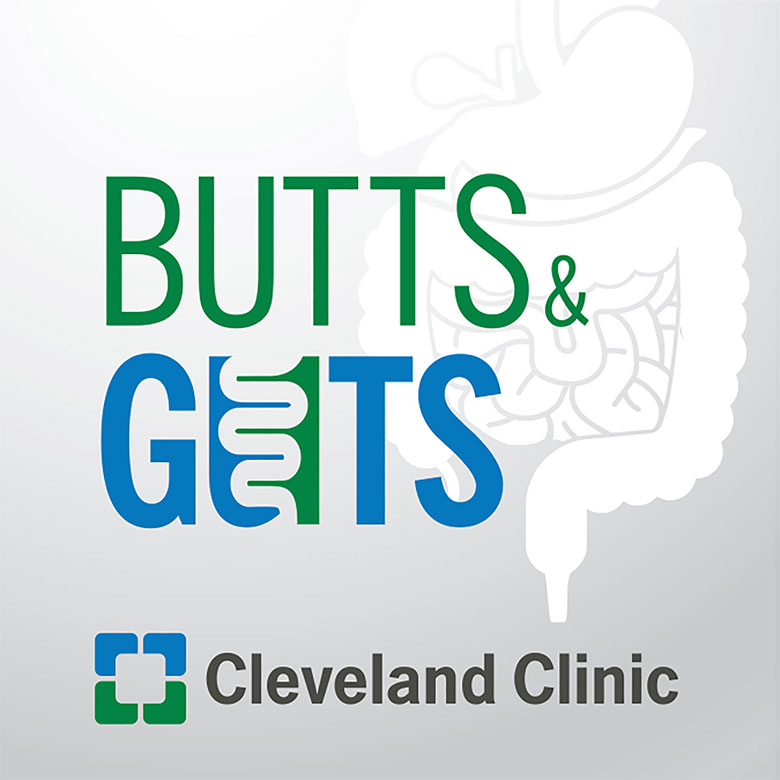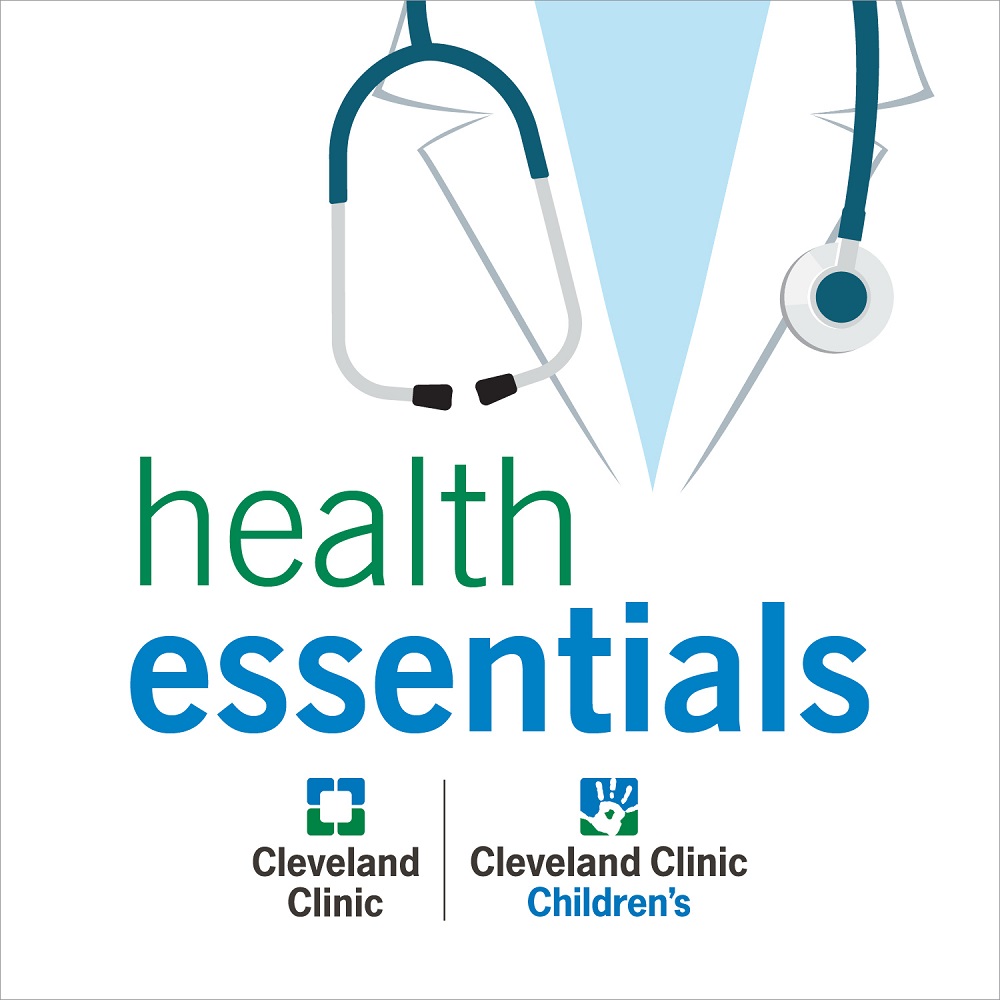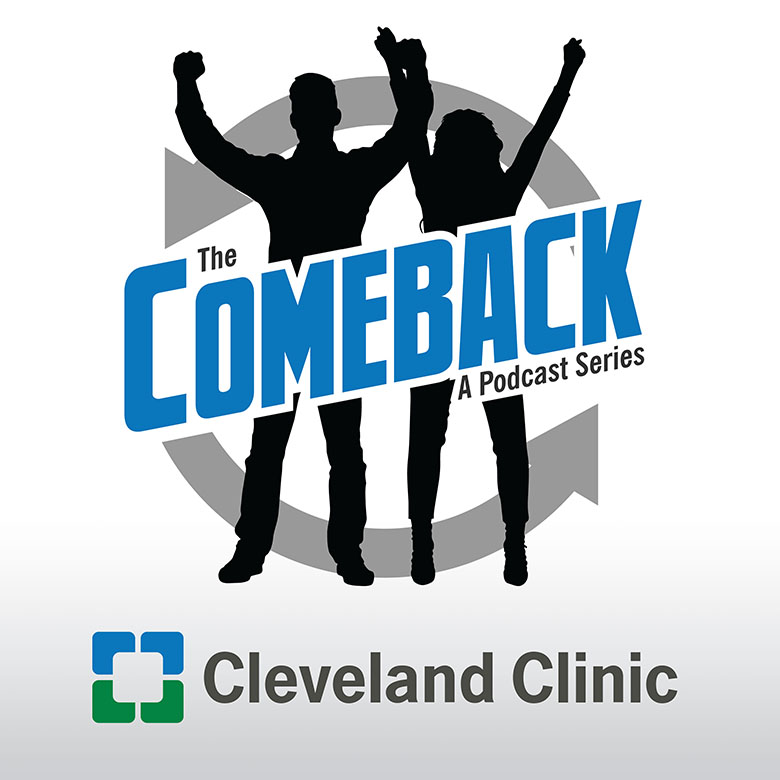Ask the Heart Doctor: Aortic Aneurysm Diagnosis & Prevention
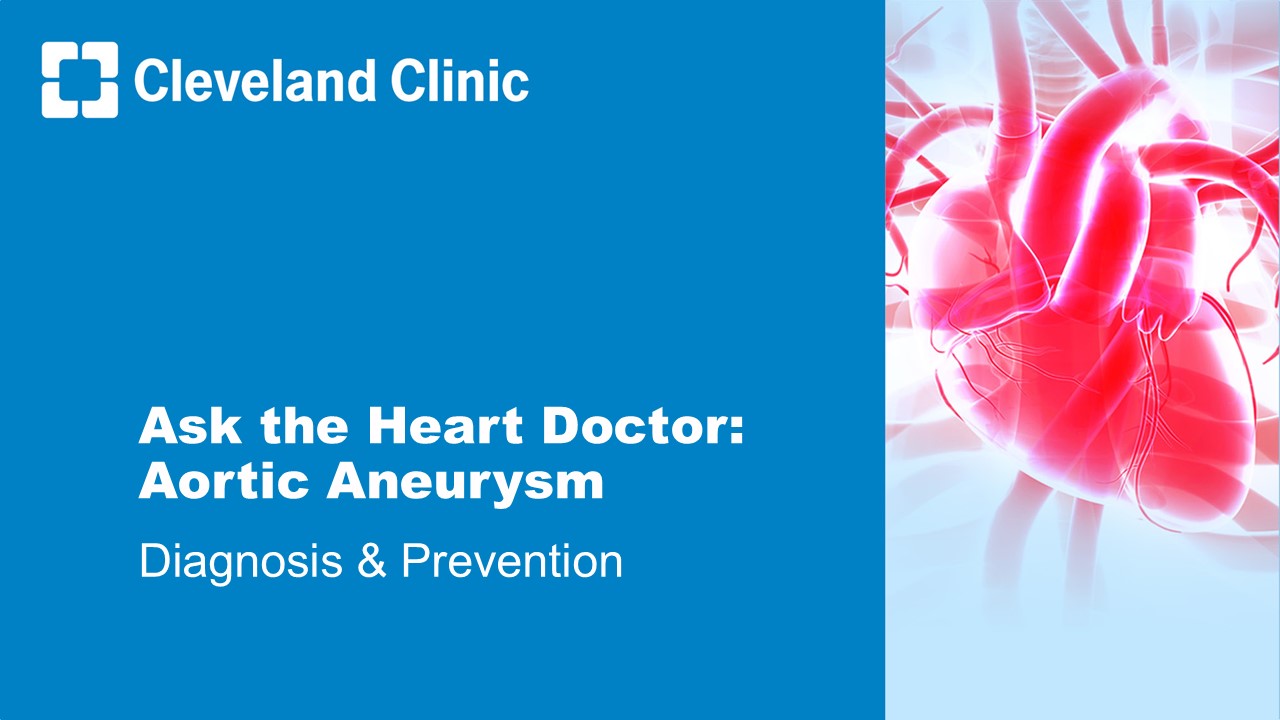
The aorta is the large blood vessel that moves blood from the heart through the rest of the body. Sometimes, genetic conditions, heart valve and blood vessel diseases or lifestyle choices can cause a bulge in the aorta, called an aortic aneurysm. A panel of heart experts will explain causes, diagnosis and treatments for thoracic aortic disease, also known as aortic disease, that occurs within the chest.
Learn more about our heart experts:
Vascular surgeon Francis Caputo, MD
Cardiologist Milind Desai, MD, MBA
Cardiologist Vidyasagar Kalahasti, MD
Cardiothoracic surgeon Eric Roselli, MD
Cardiothoracic surgeon Patrick Vargo, MD
Schedule an appointment at Cleveland Clinic by calling 844.868.4339.
Subscribe: Apple Podcasts | Podcast Addict | Buzzsprout | Spotify
Ask the Heart Doctor: Aortic Aneurysm Diagnosis & Prevention
Podcast Transcript
Announcer:
Welcome to Love Your Heart, brought to you by Cleveland Clinic's Sydell and Arnold Miller Family Heart, Vascular and Thoracic Institute. This podcast will explore disease prevention, testing, medical and surgical treatments, new innovations and more. Enjoy.
Eric Roselli, MD:
Hello, everyone. Welcome to Ask the Doctor webinar focused on thoracic aortic diseases of the chest. I'm Eric Roselli, the Cardiac Surgical Director of the Aorta Center here at the Cleveland Clinic. Cleveland Clinic is the largest aorta center in the Western Hemisphere. We do nearly 1,500 aortic operations a year. Most of those involve the thoracic aorta, or the portion of the aorta in your chest, and we do it really well. The way that we're able to take care of all those problems is with an entire team. It's not only a team at many levels, but even at the leadership level, there are many members of this team. I'm here with many of the leaders of that team today to answer your questions about thoracic aortic disease. I'm just going to ask each of my colleagues on the panel here to introduce themselves. Milind, if you want to start from that end.
Milind Desai, MD, MBA:
Hello, everybody. Thank you for joining. I'm Milind Desai, I'm a Vice Chair of HVTI (Heart, Vascular and Thoracic Institute) and the medical director of the Aorta Center. It's great to be on this panel.
Vidyasagar Kalahasti, MD:
Hi, my name is Sagar Kalahasti. I'm the Director of the Marfan and other Vascular Connective Tissue Disorders Clinic in the Aorta Center. Glad to be here and thanks for the invitation.
Francis Caputo, MD:
Hi, good morning. My name is Frank Caputo. I'm the Vascular Surgery Director of the Aortic Center, and again, I'm honored to be on this panel.
Patrick Vargo, MD:
Hello, my name is Patrick Vargo. I'm one of the heart and aorta surgeons here. I work in the Aorta Center with these colleagues of mine. Happy to be here and thank you for joining us.
Eric Roselli, MD:
We're here to answer questions from patients, and fortunately several of our outstanding nursing team members who handle a lot of phone calls and educational opportunities for our patients gathered several questions for us. I think some of the first set of questions surround this idea of really “What is my aorta and what are the diseases that affect it?”
Many of us take for granted that there are five liters of blood flowing through our body on a regular, pretty constant clip every minute, and it's the aorta that carries that. A lot of the concern that people have is just them learning the lingo and the language around some of their diagnoses. Sometimes they hear they have aortic dilatation or aortic ectasia, aortic aneurysm. Milind, maybe, can you expound on this and sort of clarify some of these questions that patients are concerned about with this?
Milind Desai, MD, MBA:
Yes, thank you. In puristic terms, what is an aneurysm, especially in the ascending or the front part of the aorta, which is close to the heart? Aneurysm is defined once your aorta reaches about five centimeters or higher. Anything less than that is not technically an aneurysm, and that's why in, puristic terms, we would call that a dilation or ectasia. People have thresholds: mild, moderate ectasia. Then once it reaches five centimeters, especially in the ascending aorta, that's an aneurysm. The definition of an aneurysm is different, say, in the abdominal aorta, where the numbers are lower, but from an ascending perspective, five centimeters is the threshold.
Eric Roselli, MD:
Really though, we're talking about an enlarged aorta, right?
Milind Desai, MD, MBA:
Yes.
Eric Roselli, MD:
So, these are all sort of synonyms in a way, but they kind of carry a little different context. Can you expound upon that a little bit for us, Dr. Kalahasti?
Vidyasagar Kalahasti, MD:
When you look at the reporting of the aortas and dilations, there are institutional differences, also like the radiology reports. Some institutions would call anything larger than a normal size as an aneurysm. That's probably not the correct idea, because then you are saying that anybody with maybe a millimeter larger than what is expected, you don't want to call that an aneurysm. Again, when we look at the actual definition, one and a half times they expect a diameter, that's the other technical definition that you'll see. Also, keep in mind that aortas do tend to get slightly larger with age and also there are some studies looking at the patient's body size and gender. You have to keep all those things into the context when you're interpreting these reporting systems.
Eric Roselli, MD:
I tend to tell my patients, don't worry about those words too much, because even the size is not necessarily an absolute indication for us to do anything, or put you at an absolute risk if we don't do anything. There's a lot of other factors that relate to your risks, like your family history. We'll get into some of those details, but the reason we worry about an aorta being enlarged is because at some point it gets too large, and you can have a complication from it.
Another question patients had for us was, “What is an aortic dissection?” Dr. Vargo, do you want to handle that one?
Patrick Vargo, MD:
Yeah, certainly. The aorta has been described as this large blood vessel in the body. As blood travels through, the wall of it is not just one layer, but rather three layers pressed together. When these aortas are dilated or fragile or have some predisposition to having an injury to them, what often happens is that blood will force its way into the wall of the aorta and travel along the length of it. It's within the wall creating a false passageway or a false lumen, you may have heard before if you had a CT scan or an echo or something. That false passage, that false lumen, is a secondary channel of blood through the wall of the aorta that shouldn't be there. When it's in the acute or emergency setting, when it just happens, there's a risk that that could cause either poor blood flow to branches off the aorta to legs, organs, or brain. Or there's a risk that could actually cause it to rupture all the way where you would have internal bleeding. Depending on where it occurs in the body dictates how we describe it. Whether it's in the chest alone or chest and abdomen, whether it's close to the heart or far away, there are different ways to describe it, and based on those locations and what it's causing, dictates how we treat that.
Eric Roselli, MD:
When a dissection happens, though, you're at risk for death, like an immediate or very emergency kind of risk for death. That's a serious problem we take care of all the time. Dr. Caputo takes care of a lot of ruptured aortas in the abdomen and then a lot of dissected aortas in the chest. What puts patients at risk for those things, Dr. Caputo? Can you explain?
Francis Caputo, MD:
I think the number one risk factor putting these patients at risk for ruptured aneurysm is not knowing they have one, right? Like you mentioned, family history, going to your doctors and getting some screening is really important. The unknown aneurysm in the belly puts you at risk because you don't know about it. We talked about size threshold and everything, and one of the risk factors is diameter, right? You're going to hear, so we talked about size, we talked about four and a half. In the belly, in the abdomen, we worry about five and a half centimeters for males, five centimeters for females. That's what kind of puts you at risk potentially for a ruptured aneurysm. We're not talking where you have to be rushed to the hospital because you were found to have an aneurysm, because the rupture risk is relatively low, but it's something that we should identify and address.
When you mentioned dissections, we talked about when we deal with dissections immediately. Most of the time it is not rupture, although that does happen, but most of the time it's signs of malperfusion or cutting the blood flow off to the leg, cutting blood flow off to the intestines or your vital organs. Those are things that we have to address immediately. That's one of the things that we do together so often, whether it's a type A, or one that begins in the heart and we have to do some other maneuvers or stenting, or whether it's something that starts in the chest and we have to work together. But the reality is dissections are also dangerous, because if you survive the early phase of dissection, we have to remember that it can lead to growth and aneurysms later on.
Eric Roselli, MD:
It's something that we're seeing at an increasing rate. About 20% of the open heart surgeries we perform at the Cleveland Clinic involve the aorta, and the thoracic aorta, particularly. If you look at the national database from the Society of Thoracic Surgeons, there has been at least a 37% increase over the last five years in aneurysms involving the first part of the aorta. It now represents 8% of what's done across the country. I think, to your point, Dr. Caputo, about knowing whether you have this problem, we're seeing an increased awareness of the problem, and we're better at picking up on it. There are screening programs for abdominal aneurysms. You can feel your aorta inside your abdomen, well, some people can. In your chest you can't, but there are other clues. Dr. Kalahasti, I know you spend a lot of time seeing a lot of families that are at risk. Can you talk a little bit about what are some of the familial risks and who should be screened for these things?
Vidyasagar Kalahasti, MD:
There are certain very well-defined genetic diseases that cause aortic aneurysms. The most classical one is Marfan syndrome. There are a few other syndromes such as Loeys-Dietz syndrome. Certain patients with vascular Ehlers-Danlos syndrome get aortic aneurysms. The other congenital birth defect is bicuspid aortic valves. In general, those are probably the four big groups of patients, or if you have any family member with a diagnosis of dissection or an aneurysm, everybody should be screened. Those are probably the five big groups of people who should be aware of an aneurysm in the family, and also their family history, genetic diseases in the family. Those are the ones that we definitely recommend family screening and monitoring for aneurysms. There are other patients where we randomly do see them, where we have done a scan looking for something else, and we find an aortic aneurysm in those patients. Sometimes we do recommend screening of those patients also, but genetic testing can be very helpful in some of those patients.
Eric Roselli, MD:
So, Dr. Desai, we see people getting imaging for lots of different reasons. One of the things that's happening more commonly is people are getting these calcium score scans, which isn't really an aorta scan, but it's a pretty good view inside the chest. A couple of our patients' questions are “What do we do if there's calcium in my aorta?” Tell us a little bit about what's happening with these calcium score scans, and maybe we're finding more aortic disease with those.
Milind Desai, MD, MBA:
There are two questions in there. The second one, I'll address first. Like a lot of other places, we are doing a lot of calcium scoring scans. These are scans that are primarily designed to detect premature or coronary artery disease, so plaque buildup in your coronary to predict the risk of a future heart attack. But a few years ago, when we looked at these patients, almost 2,000 patients, our patients that had a calcium scoring CT, we found that about 8-10% of them had a dilated aorta. That’s additional free information that we get from these scans. Once you identify these dilated aortas, then you fall in the category that Dr. Caputo was talking about. Now, you stumble upon something potentially unknown and you then get into a pathway of imaging related follow-up, be it different modalities that we will talk about, so that you can establish a baseline and ascertain progress or stability of the disease.
Now, the second question there was what does calcification of the aorta mean? Calcification within a blood vessel represents plaque buildup. The plaque is directly associated with cholesterol deposition and atherosclerosis. Essentially, what do you do? You consider plaque on your aorta similar to plaque in your coronary arteries, and the treatment for that is risk factor modification. Control your cholesterol levels as well as other risk factors like high blood pressure, obesity. Those risk factors are common between coronary disease, aortic aneurysm and aortic calcification.
Eric Roselli, MD:
Right. There are two quite different diseases, though, right? A lot of people with aneurysms don't have atherosclerosis or calcium. Wouldn't you guys all agree?
Milind Desai, MD, MBA:
Yeah.
Eric Roselli, MD:
Yeah. Those are kind of different problems. We're learning that a lot more of thoracic aortic disease is familial. I think something for the audience to understand, we've been talking about these sizes. When your aorta is enlarged, there is sort of a bell curve of normal. Nobody's aorta, no matter how old they are, because our aortas grow as we age, is supposed to be much bigger than about 4.2 centimeters or something like that. Then we start talking about how we can watch it grow for quite a long time. Sometimes it's not just years, but even decades that it takes to get to a point.
So, if you have one of these diagnoses, and again, we use these other words like dilatation or ectasia because we're trying to soften the blow a little bit, but you don't have to be afraid of it. You just need to find somebody who knows it, and work together with them to follow it. When you're following it and you're getting these imaging studies, there are a lot of different kinds of images to get.
One of our patients was asking about CT versus MRI, and they have some kidney disease, so they're wondering about contrast. Dr. Vargo, what's the best way to look at somebody's aorta when you're following them along? They meet you when it gets a little bit bigger and it's getting closer to surgery, but let's say you're not going to operate yet.
Patrick Vargo, MD:
Yeah. I think there are a few things to consider, things like kidney disease and whatnot. When I look at a patient, especially in the chest, the imaging modality I like to look at the most for an accurate measurement is a CT scan with contrast that really lights up the aorta. Then if it's in the chest, we like to gate it, or time it to the heartbeat, so that we get rid of any kind of blurry motion from the movement of the heart, which is close to that part of the aorta.
Now, there are other options as well for patients that maybe have kidney issues or we've been following them for a while, and we don't want to keep giving them contrast boluses or contrast loads and multiple radiation doses with CT scans. The other option mentioned is MRI or MRA, which uses magnetic resonance imaging. It does not use radiation the way the CT scan does. When you're following younger patients or patients over a long time, they can be very useful to screen with, avoiding a radiation dose. Also, they don't require contrast that can injure the kidneys as well, so that's one way to deal with that.
But even within the CT scan option, a CT scan without contrast, while maybe not quite as detailed as one with contrast to see the borders of the aorta, can often be a good start if we're trying to balance risk of kidney disease versus risk of aneurysm determination of do you have one or not. But for us, I think surgeons who are going to the operating room, we often like to see a CT scan with contrast as kind of a final decision maker to make sure that we're seeing everything we like to see before committing somebody to an operation.
Eric Roselli, MD:
And when we're following these, there may be a couple of different tests that we get. Some patients were asking about echocardiography. Dr. Caputo, do you get echoes in all your patients?
Francis Caputo, MD:
If I'm operating on them just to check out the heart function, but I don't monitor their size necessarily through echo. The benefit of a lot of things that I deal for the abdominal, again, we can use ultrasound on a lot of patients depending on body habits and stuff, particularly if you're a centimeter below threshold, so under five for males or under four and a half for females. That gives us a good clue with low risk. Of course, now, I know some of my colleagues use echo to monitor the ascending and stuff, and I think that's probably not a bad way to go because it's not invasive and it's low risk. There's minimal risk to you, particularly if you're below size threshold.
Eric Roselli, MD:
Right. We can look at some things with ultrasound, which is simple, but there's limitations to those views. Dr. Desai, want to comment on that?
Milind Desai, MD, MBA:
Yeah. I think with echo, to serially monitor aorta, especially ascending aorta, you have to know where the limitations are. Often, you may not realize that you are doing the wrong measurements or that the measurements are wrongly reported. Like Dr. Vargo suggested, if the decision is about taking the patient to surgery, almost none of us would make it based on a simple echocardiogram. Echo may be used to assess what's happening with the aortic valve or the heart function simultaneously, but all of us would get some sort of a gated tomographic scan.
Eric Roselli, MD:
Yeah, what we call cross-sectional imaging, I like that. You get images through the whole chest. With the ultrasound, you're just getting a beam and a peek at things, and sometimes the biggest part of the aorta just can't be captured with an ultrasound. Dr. Kalahasti, you wanted to add something?
Vidyasagar Kalahasti, MD:
Yeah, I think for patients with bicuspid valves, echocardiogram is quite useful because you want to look at the valve function too, because it's not just the aneurysm that determines the timing of surgery. The bicuspid valve function, sometimes, if it is narrowed or if it's leaking, that can lead you to surgical threshold. I think echocardiogram definitely plays a big role in that.
Eric Roselli, MD:
That's a great point. Some of the questions we got, a patient asked, “How did their aorta shrink?” So, they don't, unless Dr. Vargo and Caputo cut it out, then it shrinks. But I think the important thing for a patient to understand is that if you're looking at numbers and you're following numbers, that you're looking at them using the same modality of imaging. You can't compare an echo to an MRI or necessarily a CT scan to an MRI, although those two tend to sort of jive a little bit closer in their numbers, right?
Another question someone was asking about was, “What can I do if I have some aortic problems to keep it in check?” There are some questions about blood pressure. What do you guys recommend to your patients?
Vidyasagar Kalahasti, MD:
General blood pressure control is very important. If you look at the guidelines from the ACC/AHA, we tend to focus on two groups of medications primarily. One is called a beta blocker, which tends to slow your heart rate, and that helps in getting your blood pressure down. Another medication called angiotensin receptor blockers like Losartan, Valsartan, those kinds of medications are ACE inhibitors. Those should be your primary go-to medications for heart rate and blood pressure control. But not everybody can tolerate these medications. Then, you'll have to look at other blood pressure medications to keep things under control. But that's the most important medical thing you can do. Again, if you're heavier, then that has an impact on your blood pressure. So, weight loss definitely helps in lowering your blood pressure without just adding more medications. But I think those are probably the two most important medications that I would say are used for patients with aortic disease.
Eric Roselli, MD:
Thank you guys for your time this morning. Always enjoy talking about aortic disease and sharing knowledge with our patients. Thank you all for joining us. There will be opportunities for you to reach out to us.
Announcer:
Thank you for listening to Love Your Heart. We hope you enjoyed the podcast. For more information or to schedule an appointment at Cleveland Clinic, please call 844.868.4339. That's 844.868.4339. We welcome your comments and feedback. Please contact us at heart@ccf.org. Like what you heard? Subscribe wherever you get your podcasts, or listen at clevelandclinic.org/LoveYourHeartPodcast.
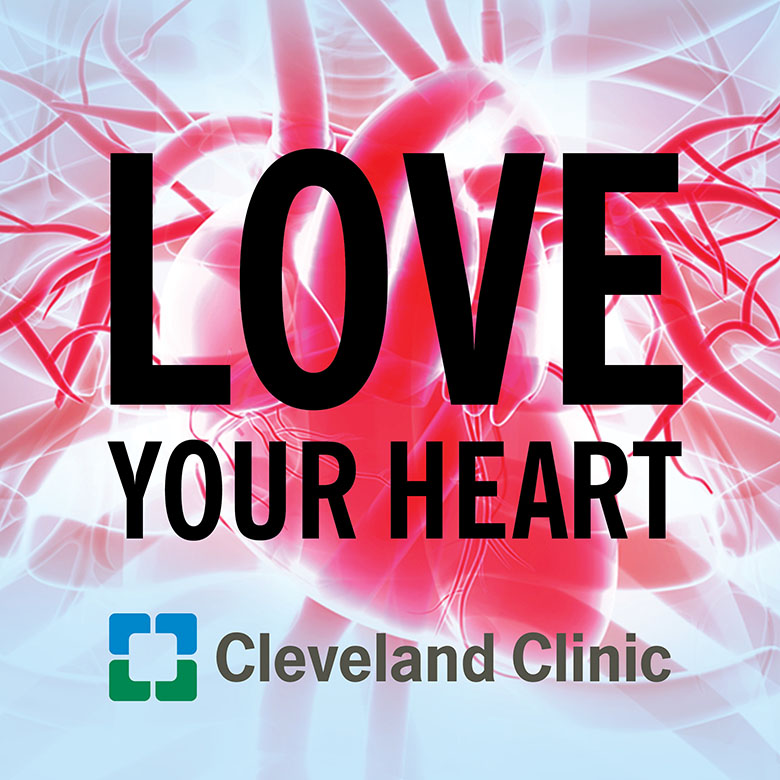
Love Your Heart
A Cleveland Clinic podcast to help you learn more about heart and vascular disease and conditions affecting your chest. We explore prevention, diagnostic tests, medical and surgical treatments, new innovations and more.
